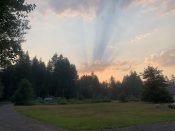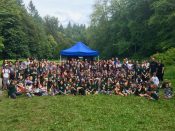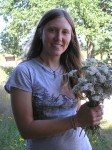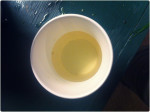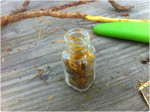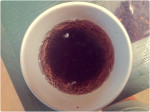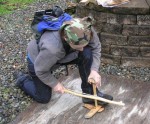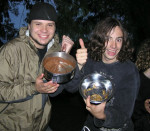The following plants which are native to the Pacific Northwest either 1) are scientifically proven to effectively treat health issues, or 2) I have personally tested to work. However, many of them should only be used under the care and advice of a naturopathic physician. Please seek medical advice and never rely on internet advice to treat problems.
Plant Properties You Need To Learn from Botany in a Day
 This article is designed to help the beginner cut out the chaff, and start studying the plants that will give a solid foundation of knowledge. But it’s not even the whole plant you need to learn: the properties inside the plant are what’s important. For that, the best essay I’ve ever found is in the appendix of Botany in a Day by Thomas J. Elpel. You really need to read his wonderful 10 page essay on herbal properties if you ever want to understand herbal medicine. Elpel outlines the plant properties this way:
This article is designed to help the beginner cut out the chaff, and start studying the plants that will give a solid foundation of knowledge. But it’s not even the whole plant you need to learn: the properties inside the plant are what’s important. For that, the best essay I’ve ever found is in the appendix of Botany in a Day by Thomas J. Elpel. You really need to read his wonderful 10 page essay on herbal properties if you ever want to understand herbal medicine. Elpel outlines the plant properties this way:
1. Carbohydrates, inlcuding starches, monosaccharieds, disaccharides, polysaccharides like cellulose, inulin, mucilage, pectin, and gum.
2. Glycosides including sulfur clycosides, cyanide glycosides, and phenol glycodies like simple phenols, flavonoids, coumarins (dicoumarols and furanocoumarins), anthraquinone glycosides, cardiac glycosides, and saponins.
3. Acids including tannic acid, oxalic acid, citric and tartaric acid, and formic acid.
4. Acrids.
5. Latex.
6. Alkaloids (narcotic and otherwise) including indole alkaloids, quinoline alkaloids, isoquinoline alkaloids, purine alkaloids, pyrrolidine and tropane alkaloids, pyridine and piperidine alkaloids, pyrrolizidine and quinolizidine alkaloids, and terpenoid alkaloids.
7. Volatile or Essential Oils which are combinations of aroma
8. Resins.
9. Bitters.
10. Gelatin.
Most Important Native Medicinal Plants, Part 1: Non-Flowering Plants

Seaweeds: Algea is not usually classified as a plant, but rather is its own Kingdom of life, and humans are one of the the only mammals I know of that eats it. According to Northwest seaweed specialist, Ryan Drum, Ph.D, all the seaweeds north of approximately the 40th parrallel are considered edible, whereas south of there may develop undetectable toxins due to warmer water, so more research should be done on that. Seaweeds are divided into the “reds,” “browns,” and “greens.” Like the plant kingdom, algea contain myriad nutritional and medicinal constituents, so you should research the ones you eat to make sure you are not receiving too much of something, such as salts or other minerals like iodine. People inland are often deficient in both, which is why iodine is added to table salt. However, you can easily overdose in iodine. As for medicinal uses, seaweeds are very popular, and may offer future revelations for curing cancers and other maladies, but in the meantime, just read Medicinal Uses of Seaweeds by Ryan Drum, Ph.D. for a great sample.
Lichen: Again, this is another form of life commonly thought of as a plant, but in reality, it is a fugus that cultivates algea! The most famous medicinal lichen are from the Usnea genus species, and there are many kinds in our region. Usnea species are easy to identify: just take some off alder, oak, apple or other tree branches, pull it apart slowly, and if you see a latex-like cord stretching out, then you’ve got it. Usnic acid is the compound inside this “plant” that seems to be the source of its medicine. In fact, usnic acid is strongly anti-bacterial. A tincture would be best to draw-out the uscnic acid, but you can make a hot tea in case you need a strong antimicrobial in the backcountry. Some modern products like sunscreen and toothpaste contain usneac acid to ward off microbes and extend their shelf lives.
From the Moss Division: I’ll include Sphagnum centrale or Peat Moss so the beginner can learn that this division includes non-vascular (no veins) spore plants, but mostly because Sphagnum moss grows in bogs, where the water is highly acidic and rather inhospitable to bacteria. This may be one of the reasons Sphagnum moss was used to pack wounds, most famously during World War I, and is still recommended today for use as feminine pads and other applications. By the way, there are about 15,000 other true mosses, plus other nonvascular spore-producing divisions including about 100 Hornworts and about 10,000 Liverworts.
From the Club Moss Division: I’ll include the Lycopodium genus so the beginner can learn that this division is vascular with about 1,000 species. Herbalists that I know recommend this plant as an topical (not internal) anti-microbial stiptic to stop bleeding. Also, in quote from Botany in a Day: Today club moss spores are sold as “vegetable sulpher”; the powder is dusted onto diaper rashes, bed sores, and herpes eruptions. The spores contain a waxy substance that is soothing on the skin and it repels water.
From the Horestail Division: There is only one genus in the horesetail division, another vascular spore-producer, with 23 species worldwide. Here in North America, Equisetum avense or Scouring Rush. Due to its high silica (glass-like) structural content, I have used it to clean myself, including as a toothbrush, but due to its many side effects, it should be used internally only under the care of a naturopathic physician.
From the Fern Division: There is a Grape Fern family, and a Water Fern family, but we are most familar with the many species within the common Fern Family, conaining 36 genera and 200 species in North America, out of the 170 genera and 8,000 species in this division world-wide. As an example of one popular fern used for medicine, Northwest herbalist, wildcrafter, and permaculturist Michael Pilarski gathers Licorice Fern, Polypodium glycyrrhiza also known as Polypodium vulgare which grows its rhyzomes (root stems) through thick moss patches, especially on trees in wet climates. Native peoples in our area have told me that the Licorice Fern rhyzome is chewed for viral infections like sore throat and colds, and perhaps the volatile oils, plus certain vitamins (C) and minerals (zinc), help cure viral infections faster than their normal duration, but this plant is intense (sucking on it, rather than chewing, is plenty strong) and needs further research.
Feeling Overwhelmed? Just Start with the Conifer Division
Learning plants can be overwhelming, so what I recommend to everyone is just start with conifers. There are only a few, and you can learn them in a day. You will feel like you have a solid foundation from which to grow, and feel confident in one area of life, taxonimically speaking:)
The Pine Family is the largest, but it only contains 6 genera, and I bet there are 6 or fewer native pine species in your local area. A change in elevation may add a few more. For instance, in the lush Pacific Northwest coast, where pines love to grow, we have Grand Fir from the Abies genus, Sitka Spruce from the Picea genus, Shore Pine from the Pinus genus, Douglas Fir from the Pseudotsuga genus, and Western Hemlock Tree from the Tsuga genus. Anything else is a rarity, usually planted by someone, found in one of the few remaining bogs, or you live at a high elevation, such as the Tamarack from the Larix genus which is common in boreal forests. Most pine family trees have edible nuts, bark that is edible if prepared correctly (cambium from huge trees, chipped and fried), and high levels of vitamin C in their needles. Medicinally, pines are astringent and can be used where that effect is indicated, but historically, it is best know for its pitch to patch up cuts, but care should be exercises so as not to introduce infection.
The Yew Family includes 5 general and 20 species worldwide, with 2 genera in North America. Most yew trees are highly poisonous, so this is one of two reasons why it is critical to identify them, as they are a look-alike to pine family trees like Tsuga and Abies. However, the most important reason to know yew trees, especially the Pacific Yew (Taxus Brevifolia), which is the source of Taxol, a compound found in its bark that is responsible for the dramatic increase in breast cancer cure rates during the 1990’s. To that end, I highly recommend reading the appendix chapter entitled “Testimony” by Terry Tempest Williams in her book An Unspoken Hunger, which describes the importance of the Pacific Yew in dramatic terms following the death of her mother and sisters from cancer years earlier.
The Cypress / Cedar / Juniper Family includes great antifugals. The Western Red Cedar (Thuja plicata), for instance, is considered the Tree of Life along the Pacific Northwest Coastal areas because it doesn’t rot, in large part due to its antifunal qualities. Homes, boats, clothing and much more were, and are, made from cedar because it lasts a long time in wet climates where fungi otherwise thrive. However, some fungi can colonize, so just like there are numerous choices for antifungal cremes in the store, various cedar species will work against certain fungal infections. It is generally safe to try soaking your feet in a tea of cedar for athletes foot, or burn cedar and apply the cooled ash for jock-itch. However, if taken internally for black-throat, for instance, a naturopathic physician should advise. This family of trees is not edible. The only species considered to have an edible aspect is the Juniperus for its berries. It’s even easier to learn this family of trees than it is the pines, because besides Juniper mostly throughout the Rocky Mountains and Thuja mostly in the coastal Northwest, the other genera in North America include the Calocedrus with the Incense Cedar from Oregon and into the Rockeis, the Chamaecyparis with the White Cedar in the east, and the Cupressus with the true Cypress in the southeast.
The Bald Cypress / Sequoia / Redwood Family includes 10 genera and 16 species worldwide, with just three in North America, including the Bald Cypress in the Taxodium genus, the Redwood in the Sequoia genus, and the Giant Sequoia in the Sequoiadendron genus. They have similar properties to the Cypress/Cedar/Juniper family, and along the same lines, they are the Trees of Lfe, in my opinion, due to climate change. Recently, it was shown that giant, old growth trees like these sequester more carbon than almost any other living thing. Further, the ones with anti-fungal and anti-microbial properties don’t rot very fast after they die. Therefore, they release only slowly the atmosphere the carbon they sequestered when alive. If you live in the wet climates where these two families thrive, plant them wherever they will be allowed to grow to be old!
The Mormon Tea Family is the final non-flowering plant an herbalist should learn. Besides its common name being well known historically, its latin name Ephedra has become well known in recent years as the source of Ephedrine, especially from the Chinese species Ma Huang, alghouth the compound is also found in the species common to our desert southwest. Ephedrine was used in weight-loss and energy supplements, but it lost favor after more than a dozen young people died when taking the drug in combination with exercise. It can still be found as a decongestant in commercial cold remedies.
Once you have learned the non-flowering herbal medicines, continue to Top Native Plants To Learn for Herbal Medicine, Part 2 of 2.
Learn how to confidently identify plants using their unique family patterns in this in-depth video by author of Botany in a Day, Thomas Elpel!
*** For educational purposes only. This information has not been evaluated by the Food and Drug Administration. This information is not intended to diagnose, treat, cure or prevent any disease. We recommend that you consult with a qualified health care practitioner before using herbal products, particularly if you are pregnant, nursing or on any medications. ***
*** Please read our Honorable Harvesting Guidelines before harvesting any plant material. The final guideline is of utmost importance: “Never put anything in your mouth unless you are 100% sure it is safe to ingest.” ***
Chris Chisholm is founder and co-owner of Wolf Camp & School of Natural Science. For in-depth learning, join our Weekly Online Classes:
- Tuesday Classes focus on Herbal Medicine & Plant Crafts in the autumn season, followed by Gardening & Cooking Wild Edible Food Plants in the spring.
- Thursday Classes focus on Wilderness Survival & Bushcraft Skills in the Autumn Season, followed by Wildlife Tracking & Birding in the spring.
- Saturday Classes for all ages guide you through the Wolf Journey Earth Conservation Course – Book One: The Neighborhood Naturalist.


